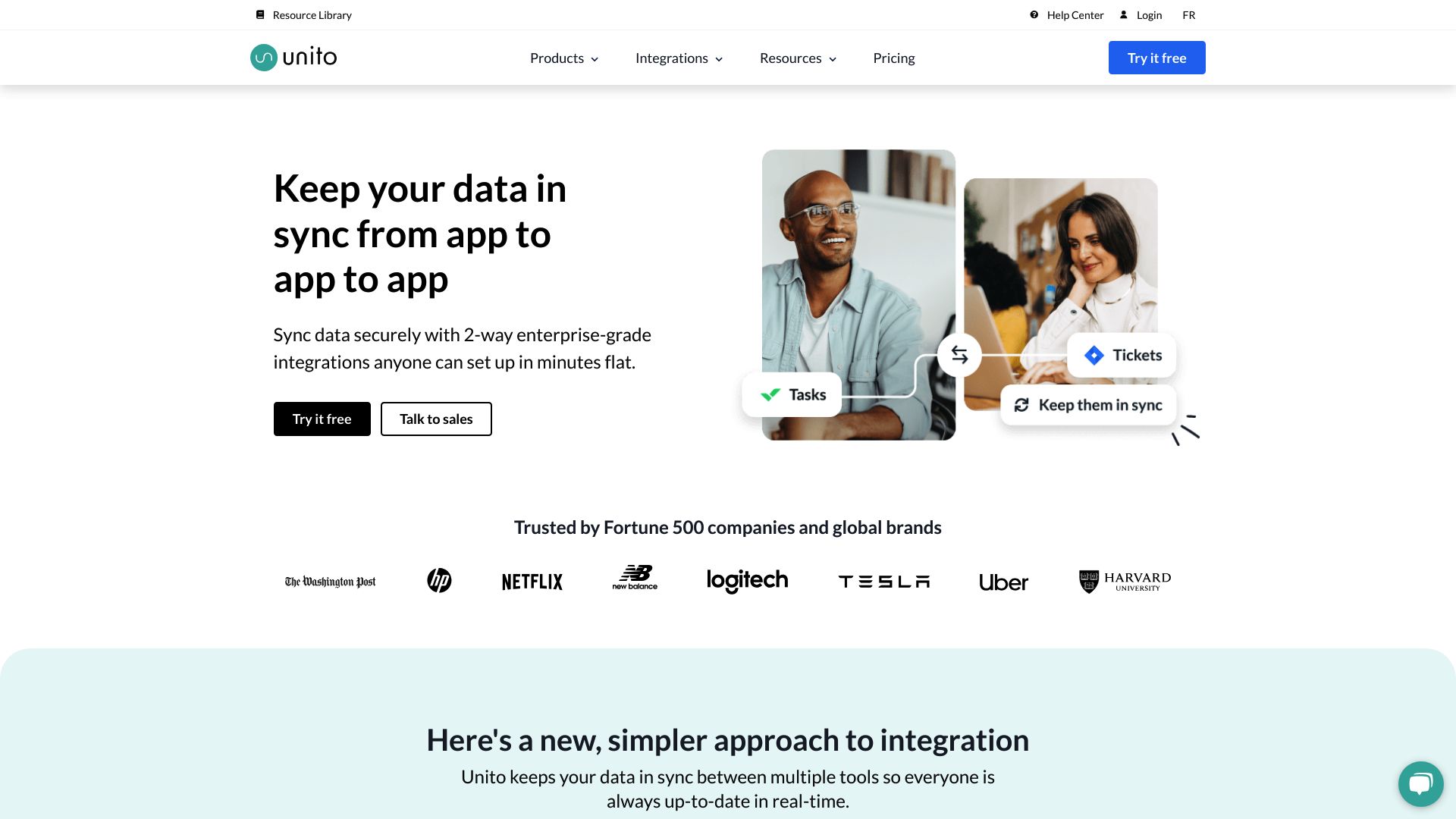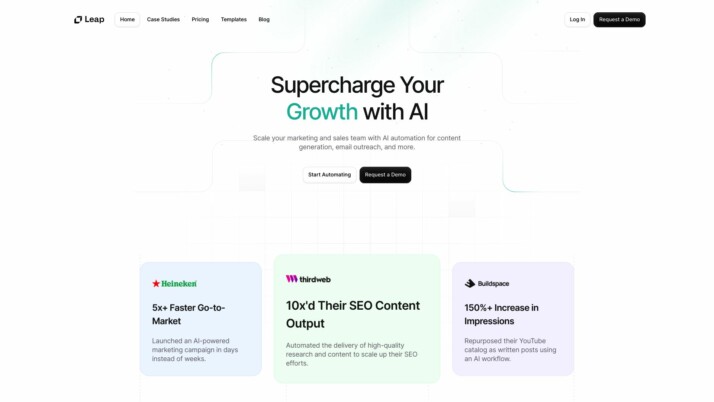Unito vs. Leap AI: Workflow Automation and AI Integration Compared
AI technology reshapes industries, offering unprecedented opportunities for innovation and efficiency. As businesses seek powerful yet accessible solutions, the market teems with platforms promising to unlock AI’s potential. This comparison delves into three leading contenders: Unito vs. Leap AI, and SmythOS. We explore their unique approaches to workflow automation, AI integration, and development capabilities. By examining core features, strengths, and limitations, we equip readers with the insights needed to choose the platform best suited for their AI ambitions. Whether you’re a developer seeking robust APIs, a business leader focused on scalability, or a non-technical user looking for no-code solutions, this analysis illuminates the path forward in harnessing AI’s transformative power.
Unito Overview
Unito provides a powerful integration platform that syncs data between various business tools in real-time. The software excels at connecting disparate systems, enabling seamless collaboration across teams using different applications.


Unito’s core offering revolves around its two-way sync technology. This feature ensures that information remains consistent across integrated tools, updating data in real-time. The platform supports deep field configuration, allowing users to customize syncing rules to match specific workflow requirements. Unito also provides historical syncing capabilities, integrating past data for comprehensive project insights.
Unito’s core offering revolves around its two-way sync technology. This feature ensures that information remains consistent across integrated tools, updating data in real-time.
The software caters to a wide range of users, from individual professionals to large enterprises. Its no-code workflow automation empowers non-technical users to create integrations without programming knowledge. For more advanced users, Unito offers extensive customization options and supports syncing of custom fields.
Unito’s platform integrates with popular tools such as Asana, Jira, Trello, and GitHub. This wide compatibility allows teams to maintain their preferred tools while still collaborating effectively. The software also includes features like attachment streaming and comment syncing, further enhancing cross-tool communication.
While Unito excels in tool integration and workflow automation, it lacks some advanced AI capabilities. The platform does not offer AI agents, autonomous agents, or problem-solving capabilities beyond workflow automation. However, its focus on seamless data synchronization and workflow optimization makes it a valuable tool for improving team productivity and breaking down data silos in organizations.
Leap AI Overview
Leap AI transforms AI workflow creation with its no-code platform, empowering users to build sophisticated AI applications without coding expertise. The platform’s drag-and-drop interface and comprehensive SDK support (RESTful API, TypeScript, Python) streamline the development process, making AI accessible to a broader audience.


Leap AI transforms AI workflow creation with its no-code platform, empowering users to build sophisticated AI applications without coding expertise.
At the core of Leap AI’s offering is a rich template library, featuring tools for diverse applications such as blog post generation, music creation, and lead summarization. This extensive collection enables rapid deployment of next-generation AI applications, significantly reducing development time. Leap AI supports a wide array of AI models, including OpenAI GPT, Mistral 7b, Claude 3 Opus, and Stable Diffusion XL, catering to tasks ranging from text generation to image creation and music production.
Leap AI excels in integration capabilities, seamlessly connecting with popular tools like Slack, Hubspot, Zendesk, and Google Search. Its user-friendly interface allows for direct workflow design and execution from the dashboard, enhancing productivity. The platform also offers AI model training features, enabling users to fine-tune custom models with their datasets for improved specificity and accuracy.
Leap AI delivers a comprehensive ecosystem for AI development, including the Leap AI Dashboard for workflow management, pre-built templates, robust APIs and SDKs, and AI model training tools. However, it lacks some advanced features found in other platforms, such as hosted agents for development and production, dedicated environments, and autonomous agent capabilities. While Leap AI provides excellent tools for building AI workflows, users seeking more complex, multi-agent systems or advanced debugging options might find the platform somewhat limited.
Leap AI delivers a comprehensive ecosystem for AI development, including… pre-built templates, robust APIs and SDKs, and AI model training tools.
Leap AI’s vision centers on democratizing AI technology, making sophisticated AI workflows accessible to users without extensive coding backgrounds. This approach positions Leap AI as a valuable tool for businesses and individuals looking to leverage AI for task automation, efficiency improvement, and innovation across various domains. The platform’s focus on user-friendly, no-code solutions opens up AI development to a wider audience, potentially accelerating the adoption of AI technologies in diverse sectors.
Feature Comparison
Unito and Leap AI offer distinct approaches to workflow automation and AI development, with notable differences in their core capabilities. Unito excels in real-time data synchronization across various business tools, providing deep field configuration and historical syncing. Its no-code workflow automation empowers users to create integrations without programming knowledge. However, Unito lacks advanced AI capabilities like hosted agents, autonomous agents, or problem-solving beyond workflow automation.
In contrast, Leap AI focuses on AI workflow creation through its no-code platform. It offers a rich template library for diverse AI applications and supports multiple AI models for tasks ranging from text generation to image creation. Leap AI provides AI model training features, allowing users to fine-tune custom models. However, it does not offer hosted agents for development and production or dedicated environments like Unito does for workflow synchronization.
Security-wise, both platforms offer data encryption, but Unito provides more robust enterprise-level security with SOC II Type 2 certification. Leap AI’s documentation does not explicitly mention advanced security features like IP control or constrained alignment. While both platforms aim to simplify complex processes, they cater to different aspects of workflow optimization and AI integration in business operations.
Feature Comparison Table
| Unito | Leap AI | SmythOS | |
|---|---|---|---|
| CORE FEATURES | |||
| Hosted Agents (Dev, Production) | ✅ | ❌ | ✅ |
| Autonomous Agents | ❌ | ❌ | ✅ |
| Explainability & Transparency | ✅ | ❌ | ✅ |
| Debug Tools | ✅ | ❌ | ✅ |
| Multimodal | ❌ | ✅ | ✅ |
| Multi-Agent Collaboration | ✅ | ❌ | ✅ |
| Human-AI Interaction | ❌ | ✅ | ✅ |
| Agent Work Scheduler | ❌ | ✅ | ✅ |
| SECURITY | |||
| Constrained Alignment | ✅ | ❌ | ✅ |
| IP Control | ❌ | ✅ | ✅ |
| COMPONENTS | |||
| Foundation AIs | ❌ | ✅ | ✅ |
| Huggingface AIs | ❌ | ✅ | ✅ |
| Classifiers | ❌ | ✅ | ✅ |
| Logic | ✅ | ✅ | |
| Data Lakes | ❌ | ❌ | ✅ |
| DEPLOYMENT OPTIONS (EMBODIMENTS) | |||
| Deploy as Webhook | ❌ | ✅ | ✅ |
| Staging Domains | ❌ | ✅ | ✅ |
| Deploy as Site Chat | ❌ | ✅ | ✅ |
| Deploy as Scheduled Agent | ❌ | ✅ | ✅ |
| Deploy as GPT | ❌ | ✅ | ✅ |
| DATA LAKE SUPPORT | |||
| Hosted Vector Database | ❌ | ❌ | ✅ |
| Sitemap Crawler | ❌ | ✅ | ✅ |
| YouTube Transcript Crawler | ❌ | ✅ | ✅ |
| URL Crawler | ❌ | ✅ | ✅ |
| PDF Support | ❌ | ✅ | ✅ |
| Word File Support | ❌ | ✅ | ✅ |
| TXT File Support | ❌ | ✅ | ✅ |
Best Alternative to Unito and Leap AI
SmythOS emerges as the superior alternative to Unito and Leap AI, offering a comprehensive platform for AI agent development and deployment. Our solution combines the strengths of both competitors while addressing their limitations, providing users with unparalleled flexibility and power.
We excel in hosted agent environments, supporting both development and production setups. This feature surpasses Unito’s workflow synchronization and Leap AI’s template-based approach, allowing for more robust and scalable AI implementations.
SmythOS emerges as the superior alternative to Unito and Leap AI, offering a comprehensive platform for AI agent development and deployment.
Our visual builder and no-code editor empower users of all skill levels to create sophisticated AI agents without extensive programming knowledge. We’ve enhanced this capability beyond Leap AI’s offerings, integrating advanced features like autonomous agents and multi-agent collaboration that Unito lacks entirely.
SmythOS stands out with its superior problem-solving capabilities and human-AI interaction features. We’ve incorporated explainability and transparency tools, along with comprehensive debugging options, addressing limitations in both Unito and Leap AI. These features ensure that our AI agents not only perform complex tasks but also provide clear insights into their decision-making processes.
In terms of deployment options, we offer unmatched versatility. Users can deploy AI agents as APIs, webhooks, site chats, scheduled tasks, or even integrate them with GPT models. This flexibility surpasses both Unito’s focus on workflow automation and Leap AI’s more limited deployment choices, opening up a world of possibilities for AI integration across various platforms and use cases.
Conclusion
Unito, Leap AI, and SmythOS each offer unique approaches to workflow automation and AI integration. Unito excels in real-time data synchronization across business tools, while Leap AI focuses on no-code AI workflow creation. However, SmythOS emerges as the superior choice, combining the strengths of both platforms and offering additional advanced features.
SmythOS stands out with its comprehensive AI agent creation and deployment capabilities. The platform’s drag-and-drop interface, extensive integration ecosystem, and support for multiple AI models make it accessible to both technical and non-technical users. Unlike Unito and Leap AI, SmythOS offers hosted agents for development and production, multi-agent collaboration, and advanced features like constrained alignment and data lake support.
While Unito and Leap AI may suit specific use cases, SmythOS provides a more versatile and powerful solution for businesses looking to harness the full potential of AI. Its ability to deploy agents across various platforms, from APIs to chatbots, offers unparalleled flexibility. Additionally, SmythOS’s focus on security, scalability, and transparency makes it an ideal choice for enterprises seeking robust AI solutions.
To experience the power of SmythOS and revolutionize your workflow with AI, create a free SmythOS account today. With unlimited agents and a 30-day money-back guarantee, you can explore the platform’s capabilities risk-free. Discover our diverse range of AI-powered agent templates to jumpstart your AI journey and transform your business processes with intelligent automation.
Last updated:
Disclaimer: The information presented in this article is for general informational purposes only and is provided as is. While we strive to keep the content up-to-date and accurate, we make no representations or warranties of any kind, express or implied, about the completeness, accuracy, reliability, suitability, or availability of the information contained in this article.
Any reliance you place on such information is strictly at your own risk. We reserve the right to make additions, deletions, or modifications to the contents of this article at any time without prior notice.
In no event will we be liable for any loss or damage including without limitation, indirect or consequential loss or damage, or any loss or damage whatsoever arising from loss of data, profits, or any other loss not specified herein arising out of, or in connection with, the use of this article.
Despite our best efforts, this article may contain oversights, errors, or omissions. If you notice any inaccuracies or have concerns about the content, please report them through our content feedback form. Your input helps us maintain the quality and reliability of our information.
